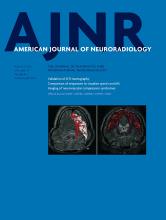Research ArticleAdult Brain
Geometric Parameter Analysis of Ruptured and Unruptured Aneurysms in Patients with Symmetric Bilateral Intracranial Aneurysms: A Multicenter CT Angiography Study
Z.-Q. Huang, Z.-H. Meng, Z.-J. Hou, S.-Q. Huang, J.-N. Chen, H. Yu, L.-J. Feng, Q.-J. Wang, P.-A. Li and Z.-B. Wen
American Journal of Neuroradiology August 2016, 37 (8) 1413-1417; DOI: https://doi.org/10.3174/ajnr.A4764
Z.-Q. Huang
aFrom the Medical Image Center (Z.-Q.H., H.Y., L.-J.F., Z.-B.W.)
cMedical Image Center (Z.-Q.H., Z.-H.M., J.-N.C.)
Z.-H. Meng
cMedical Image Center (Z.-Q.H., Z.-H.M., J.-N.C.)
Z.-J. Hou
eDepartment of Radiology (Z.-J.H.), The Second Affiliated Hospital of Guangzhou Medical University, Guangzhou, Guangdong Province, China
S.-Q. Huang
fDepartment of Radiology (S.-Q.H.), Sun Yat-Sen Memorial Hospital, Sun Yat-Sen University, Guangzhou, Guangdong Province, China.
J.-N. Chen
cMedical Image Center (Z.-Q.H., Z.-H.M., J.-N.C.)
H. Yu
aFrom the Medical Image Center (Z.-Q.H., H.Y., L.-J.F., Z.-B.W.)
L.-J. Feng
aFrom the Medical Image Center (Z.-Q.H., H.Y., L.-J.F., Z.-B.W.)
Q.-J. Wang
bDepartment of Neurosurgery (Q.-J.W.), Zhujiang Hospital, Southern Medical University, Guangzhou, Guangdong Province, China
P.-A. Li
dDepartment of Neurosurgery (P.-A.L.), Yuebei People's Hospital, Shantou University Medical College, Shantou, Guangdong Province, China
Z.-B. Wen
aFrom the Medical Image Center (Z.-Q.H., H.Y., L.-J.F., Z.-B.W.)

References
- 1.↵
- Vlak MH,
- Algra A,
- Brandenburg R, et al
- 2.↵
- 3.↵
- Van Gijn J,
- Kerr RS,
- Rinkel GJ
- 4.↵
- Ingall T,
- Asplund K,
- Mähönen M, et al
- 5.↵
- Baharoglu MI,
- Schirmer CM,
- Hoit DA, et al
- 6.↵
- Dhar S,
- Tremmel M,
- Mocco J, et al
- 7.↵
- Tremmel M,
- Dhar S,
- Levy EI, et al
- 8.↵
- Jeon JS,
- Ahn JH,
- Huh W, et al
- 9.↵
- 10.↵
- Wiebers DO,
- Whisnant JP,
- Huston J III., et al
- 11.↵
- Lubicz B,
- Levivier M,
- François O, et al
- 12.↵
- Forbes G,
- Fox AJ,
- Huston J 3rd., et al
- 13.↵
- Lin N,
- Ho A,
- Gross BA, et al
- 14.↵
- Morita A,
- Kirino T,
- Hashi K, et al
- 15.↵International Study of Unruptured Intracranial Aneurysms Investigators. Unruptured intracranial aneurysms: risk of rupture and risks of surgical intervention. N Engl J Med 1998;339:1725–33 doi:10.1056/NEJM199812103392401 pmid:9867550
- 16.↵
- Baharoglu MI,
- Lauric A,
- Gao BL, et al
- 17.↵
- 18.↵
- Rahman M,
- Ogilvy CS,
- Zipfel GJ, et al
- 19.↵
- Beck J,
- Rohde S,
- el Beltagy M, et al
- 20.↵
- de Rooij NK,
- Velthuis BK,
- Algra A, et al
- 21.↵
- Rohde S,
- Lahmann K,
- Beck J, et al
- 22.↵
- Backes D,
- Vergouwen MD,
- Velthuis BK, et al
- 23.↵
- 24.↵
- Ujiie H,
- Tamano Y,
- Sasaki K, et al
- 25.↵
- Nader-Sepahi A,
- Casimiro M,
- Sen J, et al
- 26.↵
- Weir B,
- Amidei C,
- Kongable G, et al
- 27.↵
- 28.↵
- 29.↵
- 30.↵
- 31.↵
- 32.↵
- You SH,
- Kong DS,
- Kim JS, et al
- 33.↵
- 34.↵
- Takao H,
- Murayama Y,
- Otsuka S, et al
- 35.↵
- Tateshima S,
- Chien A,
- Sayre J, et al
- 36.↵
- Lauric A,
- Hippelheuser J,
- Cohen AD, et al
- 37.↵
- Goubergrits L,
- Schaller J,
- Kertzscher U, et al
- 38.↵
- Jou LD,
- Lee DH,
- Morsi H, et al
- 39.↵
- McKinney AM,
- Palmer CS,
- Truwit CL, et al
In this issue
American Journal of Neuroradiology
Vol. 37, Issue 8
1 Aug 2016
Advertisement
Z.-Q. Huang, Z.-H. Meng, Z.-J. Hou, S.-Q. Huang, J.-N. Chen, H. Yu, L.-J. Feng, Q.-J. Wang, P.-A. Li, Z.-B. Wen
Geometric Parameter Analysis of Ruptured and Unruptured Aneurysms in Patients with Symmetric Bilateral Intracranial Aneurysms: A Multicenter CT Angiography Study
American Journal of Neuroradiology Aug 2016, 37 (8) 1413-1417; DOI: 10.3174/ajnr.A4764
0 Responses
Geometric Parameter Analysis of Ruptured and Unruptured Aneurysms in Patients with Symmetric Bilateral Intracranial Aneurysms: A Multicenter CT Angiography Study
Z.-Q. Huang, Z.-H. Meng, Z.-J. Hou, S.-Q. Huang, J.-N. Chen, H. Yu, L.-J. Feng, Q.-J. Wang, P.-A. Li, Z.-B. Wen
American Journal of Neuroradiology Aug 2016, 37 (8) 1413-1417; DOI: 10.3174/ajnr.A4764
Jump to section
Related Articles
- No related articles found.
Cited By...
- New morphological parameter for intracranial aneurysms and rupture risk prediction based on artificial neural networks
- Characteristics of Radiation-Related Intracranial Aneurysms: A Multicenter Retrospective Study
- Morphological characteristics associated with the rupture risk of mirror posterior communicating artery aneurysms
- Hemodynamic Characteristics of Ruptured and Unruptured Multiple Aneurysms at Mirror and Ipsilateral Locations
This article has not yet been cited by articles in journals that are participating in Crossref Cited-by Linking.
More in this TOC Section
Adult Brain
Similar Articles
Advertisement











